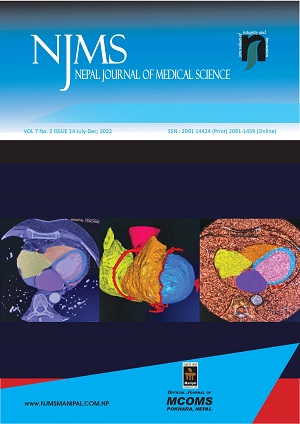Prescribing Pattern of Antibiotics in Respiratory Tract Infections in the Pediatric Indoor Patients at Manipal Teaching Hospital
DOI:
https://doi.org/10.3126/njms.v7i2.47258Keywords:
Pediatrics, Prescriptions, Respiratory Tract InfectionsAbstract
Introduction: Respiratory tract infections are the most frequently occurring illness in childhood and antibiotics are the key drugs for its treatment which account for three-quarters of all antibiotics prescriptions. Injudicious use of antibiotics leads to the development of resistance, patients are at high risk for opportunistic infections or prolonged hospitalization. This study aimed to assess the prescribing pattern of antibiotics for respiratory tract infections in the pediatric indoor patients of Manipal Teaching Hospital.
Methods: This study is a prospective cross-sectional study done in the paediatrics ward of Manipal Teaching Hospital Pokhara, conducted for six months. Patients aged range from 1 day to 14 years who meet the inclusion criteria were taken in this study. Data were collected from the inpatient ward and analysed using various statistical tools.
Results: Among 170 patients, a maximum(43.3%) were in the age group of 1 day to 11 months with male predominance(74.1%). Bronchopneumonia was the most common respiratory tract infection (51.8%) followed by bronchiolitis (13%). Chest x-ray was done in all patients however blood culture was done only in 60.6% and an antibiotic sensitivity test (27.6%) before prescribing antibiotics. Cefotaxime was prescribed in maximum patients (62.4%) followed by ceftriaxone (17.1%). All the patients received at least one antibiotic by i.v route during the hospital stay.
Conclusion: Since culture and sensitivity tests were not carried out on most of the patients before prescribing antibiotics in this study, which might lead to an increased chance of bacterial resistance and treatment failure in the future.
Downloads
Downloads
Published
How to Cite
Issue
Section
License
Copyright (c) 2022 Nepal Journal of Medical Sciences

This work is licensed under a Creative Commons Attribution 4.0 International License.
Copyright © by Nepal Journal of Medical Sciences. The ideas and opinions expressed by authors of articles summarized, quoted, or published in full text in this Journal represents only opinions of authors and do not necessarily reflect the official policy of Nepal Journal of Medical Sciences or the institute with which the author(s) is (are) affiliated, unless so specified.




